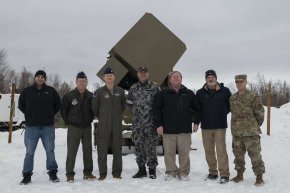Really don’t know but I think SPY 6 was specified for Flight III AB before SPY 7 (a land based radar) was considered for naval use by Japan, Spain, and Canada. As for the advantages of either, the more knowledgeable can jump in.
I do not consider myself more knowledgeable about the topic, but am willing to chime in with my thoughts (for what those are worth...)
USS Jack H. Lucas (DDG-125) the first of the Flight III
Arleigh Burke-class DDG's to be built for the USN. What I suspect is the important bit and why the design flight is to be fitted with SPY-6 and not SPY-7 has to do with when the design work was completed, as well as when the orders were placed.
I would need to do some digging to see exactly when this all happened, but the vessel was (to be) named Jack H. Lucas by the US SecNav on 17 Sept. 2016, more than three years before she was laid down. What that infers is that the first Flight III DDG was ordered on or before that date, and in order for that to have happened the detailed design work would need to have been completed.
AFAIK the first AN/SPY-7 array did not start testing until ~2018 and is not expected to be fitted aboard a ship (or at least a ship that is expected to be in commission) until ~2026 with the first of the Spanish Armada's
F110-class frigates as the AN/SPY-7(V)2.
I believe, but could be mistaken, that the first AN/SPY-7 array was for the US Missile Defense Agency (MDA) as the Long-Range Discrimination Radar (LRDR) which is a land-based installation. The LRDR itself has dual monostatic panels which measure 60' x 60' or ~18m x 18x.
Based off that, it would seem that at the time the design work for the Flight III was being done, the SPY-7 was not far enough along to be designed to fit aboard, and/or there as not enough lead time to get orders for SPY-7 which could be fitted to a vessel being laid down in 2019. Since the SPY-7 is supposed to be scale, it might be that later versions of the Flight III might be fitted with those instead of SPY-6. However, since SPY-6(V)4 is being developed to be back-fitted aboard Flight IIA DDG's, it might be that the USN is happy with the Raytheon radar and associated training, maintenance and logistics/supply chains established and does not see sufficient advantage adopting a new radar to replace a radar that is just entering service. One does need to keep in mind that SPY-6(V)1 is for the Flight III
Arleigh Burke-class DDG's, but the (V)2 was developed for US amphibs and
Nimitz-class CVN's, whilst the (V)3 is to serve aboard
Gerald R. Ford-class CVN's and
Constellation-class FFG's, that suggests that from the USN's perspective, SPY-6 does quite well.

